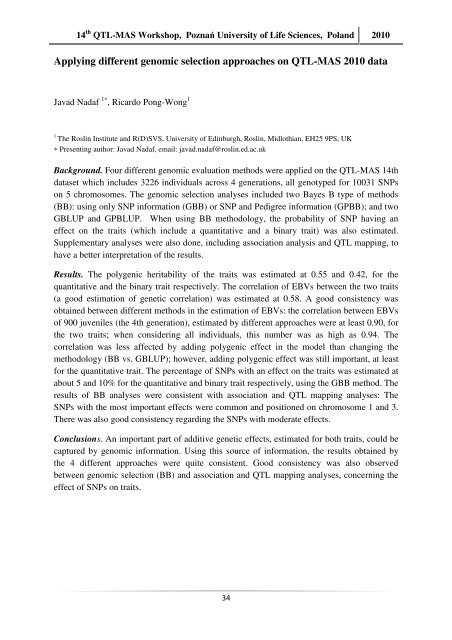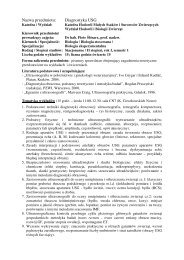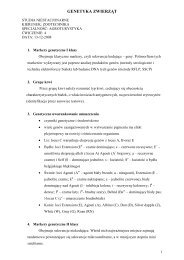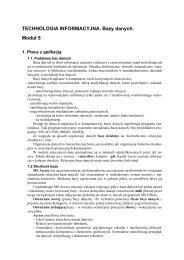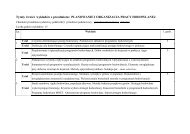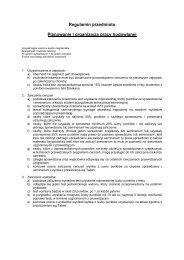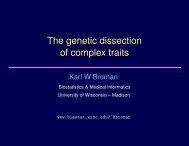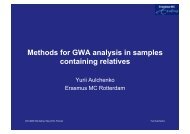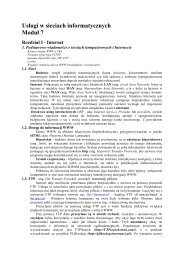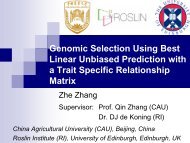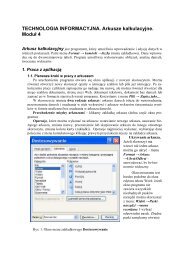The book of abstracts is available. - PoznaÅ
The book of abstracts is available. - PoznaÅ
The book of abstracts is available. - PoznaÅ
Create successful ePaper yourself
Turn your PDF publications into a flip-book with our unique Google optimized e-Paper software.
14 th QTL-MAS Workshop, Poznań University <strong>of</strong> Life Sciences, Poland 2010Applying different genomic selection approaches on QTL-MAS 2010 dataJavad Nadaf 1∗ , Ricardo Pong-Wong 11<strong>The</strong> Roslin Institute and R(D)SVS, University <strong>of</strong> Edinburgh, Roslin, Midlothian, EH25 9PS, UK∗ Presenting author: Javad Nadaf, email: javad.nadaf@roslin.ed.ac.ukBackground. Four different genomic evaluation methods were applied on the QTL-MAS 14thdataset which includes 3226 individuals across 4 generations, all genotyped for 10031 SNPson 5 chromosomes. <strong>The</strong> genomic selection analyses included two Bayes B type <strong>of</strong> methods(BB): using only SNP information (GBB) or SNP and Pedigree information (GPBB); and twoGBLUP and GPBLUP. When using BB methodology, the probability <strong>of</strong> SNP having aneffect on the traits (which include a quantitative and a binary trait) was also estimated.Supplementary analyses were also done, including association analys<strong>is</strong> and QTL mapping, tohave a better interpretation <strong>of</strong> the results.Results. <strong>The</strong> polygenic heritability <strong>of</strong> the traits was estimated at 0.55 and 0.42, for thequantitative and the binary trait respectively. <strong>The</strong> correlation <strong>of</strong> EBVs between the two traits(a good estimation <strong>of</strong> genetic correlation) was estimated at 0.58. A good cons<strong>is</strong>tency wasobtained between different methods in the estimation <strong>of</strong> EBVs: the correlation between EBVs<strong>of</strong> 900 juveniles (the 4th generation), estimated by different approaches were at least 0.90, forthe two traits; when considering all individuals, th<strong>is</strong> number was as high as 0.94. <strong>The</strong>correlation was less affected by adding polygenic effect in the model than changing themethodology (BB vs. GBLUP); however, adding polygenic effect was still important, at leastfor the quantitative trait. <strong>The</strong> percentage <strong>of</strong> SNPs with an effect on the traits was estimated atabout 5 and 10% for the quantitative and binary trait respectively, using the GBB method. <strong>The</strong>results <strong>of</strong> BB analyses were cons<strong>is</strong>tent with association and QTL mapping analyses: <strong>The</strong>SNPs with the most important effects were common and positioned on chromosome 1 and 3.<strong>The</strong>re was also good cons<strong>is</strong>tency regarding the SNPs with moderate effects.Conclusions. An important part <strong>of</strong> additive genetic effects, estimated for both traits, could becaptured by genomic information. Using th<strong>is</strong> source <strong>of</strong> information, the results obtained bythe 4 different approaches were quite cons<strong>is</strong>tent. Good cons<strong>is</strong>tency was also observedbetween genomic selection (BB) and association and QTL mapping analyses, concerning theeffect <strong>of</strong> SNPs on traits.34


